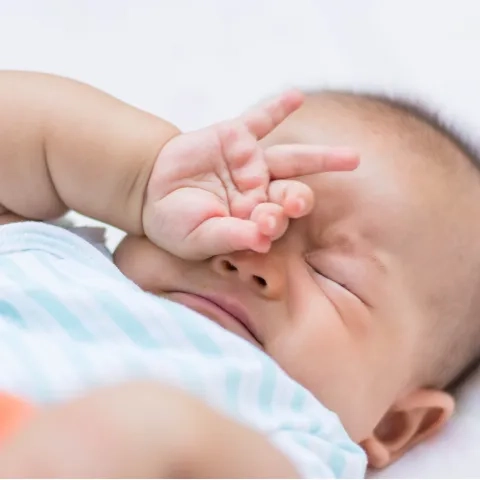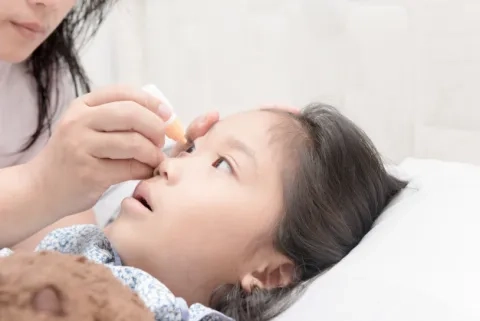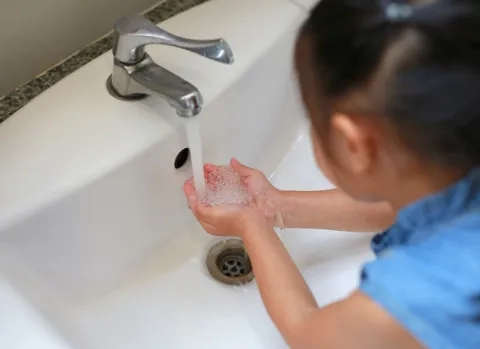Conjunctivitis in children

Conjunctivitis also known as pink eye, is an infection or inflammation of the conjunctiva of the eye1. The conjunctiva is the thin and transparent layer of membrane that lines the white part of the eye and inner surface of the eyelids2.
What is ptosis?
Allergic conjunctivitis:
This is triggered by an allergic reaction towards irritants such as dust, pollen, chlorine in the pool or sometimes cigarette smoke2. This is non-contagious and can occur all year round or seasonal, depending on the allergen that causes the allergy.
Viral conjunctivitis:
A highly contagious conjunctival infection that is usually caused by airborne viruses – adenovirus4; which transmits easily by sneezing and coughing and touching the eyes upon coming in contact with contaminated surfaces. Viral infection tends to be self-limiting and will take about 1 to 3 weeks to recover from the onset without medication.
Bacterial conjunctivitis:
This can be caused by various bacteria such as staphylococcus or streptococcus bacteria2, therefore antibiotic eye drops or ointments may be prescribed to aid in recovery.
Symptoms

There are some common symptoms2 to look out for if you suspect your child has conjunctivitis:
- Redness in the white of the eye
- Itchy or burning eye
- Gritty or sandy sensation
- Photophobia (light sensitivity)
As young toddlers may have difficulty expressing themselves, parents can look out for certain signs such as if the child is rubbing and squinting his/her eyes, avoiding bright lights or even crying and having tantrums more often due to eye discomfort.
For allergic conjunctivitis, the child may have watery eyes (usually bilateral) and this is sometimes accompanied by puffy eyelids and a runny nose. The child will also experience eye watering for viral conjunctivitis.
However, if it is caused by a bacterial infection, there will be more sticky, yellowish discharge which can sometimes cause the eyelids to stick together upon waking up.
Complication
Ophthalmia neonatorum1,2,6 (neonatal conjunctivitis) is a severe bacterial infection that can occur after a newborn baby develops conjunctivitis within 30 days of birth. This is due to the presence of chlamydia or gonorrhoea in the body which is passed on to the baby through the birth canal. Ophthalmia neonatorum will require immediate treatment as it can lead to permanent visual impairment.
Treatment

One of the treatment methods for allergic conjunctivitis is avoiding or removing the allergens. Antihistamine or nonsteroidal anti-inflammatory (NSAIDs)2 eye drops may also be required to alleviate the symptoms of discomfort.
Viral conjunctivitis is similar to common cold symptoms, where no specific medication is needed and the condition will recover on its own. However, preservative-free eye drops, artificial tears or using a cold compress can be used to keep the eyes comfortable.
Antibiotic eye drops are usually prescribed for bacterial conjunctivitis as it helps speed up the healing process. However, patients must remember to finish the entire course of eye drops to prevent recurrence.
Prevention

Prevent allergic conjunctivitis from recurring, the allergen causing the allergy should be avoided as much as possible. Both viral and bacterial conjunctivitis remain contagious as long as symptoms are present, therefore proper hygiene is very important. Some simple precautionary measures:
- Reminding toddlers to avoid touching or rubbing their eyes
- Practice thorough and frequent hand washing
- Changing bedsheets, pillow and bolster cases more often and avoid sharing towels
- Children with conjunctivitis symptoms should refrain from attending school to prevent intermingling
Last but not least, always remember to keep your child out of school when there are symptoms of conjunctivitis and seek prompt treatment at the ophthalmologist.
References:
- Conjunctivitis. Health Hub website. https://www.healthhub.sg/a-z/diseases-and-conditions/25/conjunctivitis
- Conjunctivitis. American Optometric Association website. https://www.aoa.org/patients-and-public/eye-and-vision-problems/glossary-of-eye-and-vision-conditions/conjunctivitis
- Conjunctivitis: What Is Pink Eye? American Academy of Ophthalmology website. https://www.aao.org/eye-health/diseases/pink-eye-conjunctivitis
- Adenovirus. Centers for Disease Control and Prevention website. https://www.cdc.gov/adenovirus/index.html
- Gill, K R. Pink eye in toddlers: Everything you need to know. Medical News Today website. November 21, 2019. https://www.medicalnewstoday.com/articles/327078
- Conjunctivitis (Pinkeye). WebMD website https://www.webmd.com/eye-health/eye-health-conjunctivitis#2
- Conjunctivitis. All About Vision website. https://www.allaboutvision.com/conditions/conjunctivitis.htm
Recent Blog Posts
- 19 Oct 2022
- 19 Oct 2022
- 19 Oct 2022
- 19 Oct 2022
- 19 Oct 2022
